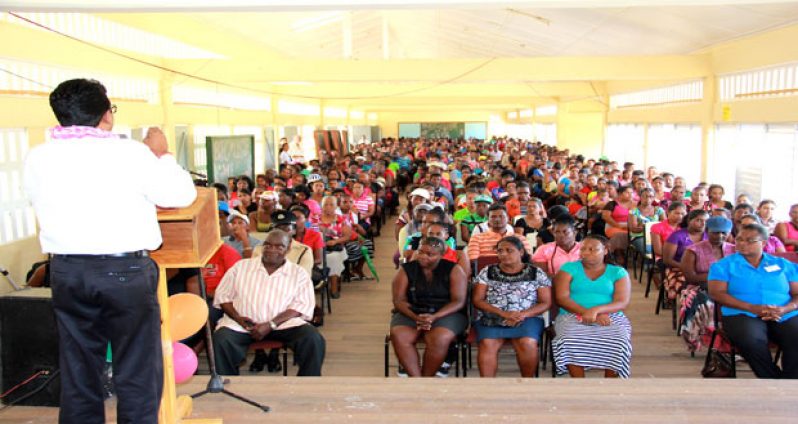OVER 800 parents and guardians turned up at the Hope Secondary School on Tuesday to uplift their cash vouchers, part of the Government of Guyana’s ‘Because We Care’ initiative.
And Attorney-General (AG)and Minister of Legal Affairs, Anil Nandlall, in his address, stressed that the current Government recognised that Guyana’s greatest asset is the children of this country.
“Every policy that we promulgate, every initiative that we implement, is designed to impact and improve the lives of our young people,” he said to the packed auditorium in the secondary school.
GREAT IMPORTANCE
He highlighted that great importance is paid to the principle of child welfare in Guyana’s Constitution.
“Over the years the Government has designed and initiated policies which are intended to target the young people of our country, with the view to better prepare them to meet the challenges of a more advanced, technological world than the one we now live in,” Nandlall said.
The AG added that the Government, in its social development thrust, continues to build new schools and increase the capacity of others; expand Technical Vocational Education (TVET) throughout Guyana; and ensure that students attending the University of Guyana have access to student loans, among other advances.
BUDGET CUTS
This year, the National Budget allocated $32.3B, over 30 per cent, of a whopping $220M budget. The national estimates were geared to fulfil the many promises made to the people of Guyana during the 2011 campaign. However, it was slashed by the Opposition. This year the cuts totalled a whopping $37.4B, reducing the $220B National Budget to $182.6B. Last year, the combined Opposition cut the Budget by $31B; and in 2012 by $21B.
Prior to 1992 the investment in the social sector was a measly eight per cent of a small national budget, as compared to the 2014 and prior budgets. Also, in 2013 for example, 15.9 per cent of the National Budget was spent in the education sector, followed by 13 per cent this year. In 1992, it was a mere five per cent.
“Every child, irrespective of where he or she lives, has equal access to education. Education has been identified as the surest vehicle to transport a people out of the vicious cycle of poverty,” Nandlall stressed.
EQUAL ACCESS
The AG emphasised that the Government of Guyana has a policy of even and equitable distribution of resources in the education sector, to guarantee every child equal access to all resources that are available in every region.
He said, “The Government has seen tremendous success from this policy… you know, that twenty years ago, only a few schools in certain urban communities were producing the top students at Common Entrance, at CXC, and at CSEC. But in recent years, more and more students from the rural areas such as Anna Reginna, Linden and Berbice are topping the entire Caribbean at CSEC.
“This year, a student from Cotton Tree on the West Coast of Berbice, topped the entire Caribbean in Technical Vocational Education. We must be doing something right!”
For 2014, Guyana took home three other awards: Aliyyah Abdul Kadir and Ryhan Chand, also of QC, who took top regional awards for Most Outstanding in Humanities and Most Outstanding in Business Studies respectively, and Kishan Crichlow of the New Amsterdam Multilateral School was awarded the Most Outstanding Student in Technical Vocational studies.
Other indicators of equal access to education include the fact that:
* Over the past 22 years Government has managed to build or refurbished more than 1000 schools across the country. Today, there are 130 nursery schools across the hinterland, 250 primary schools, and 17 secondary schools.
* A total of 72 per cent of teachers spread across the country are trained, compared to 30 per cent trained two decades ago. More than 50 percent of the teachers in the hinterland regions are trained, through the Guyana Basic Education Teacher Training Programme, and other initiatives that facilitate distance training.
* Ninety-two per cent of the clusters have access to a Learning Resource Centre (LRC).
* Ninety percent of the schools have a teachers’ house and 90 per cent are equipped with sanitary blocks, 45 per cent with electricity and 83 per cent with water facilities.
According to the AG, these are significant indicators that the current Administration’s policies, backed by significant investment in the education sector over the years, are producing tremendous results.
“It is in this context of our investment in education, and the equity of distribution of resources, that this $10,000 Education Grant must be viewed, because we care,” Nandlall said.
The $10,0000 cash grant initiative was announced by Finance Minister, Dr. Ashni Singh, during the presentation of Budget 2014, at which time he noted that the programme is meant to provide more support to parents with school-age children and increase the disposable income of parents with school-age children with a view to raising enrollment and attendance rates.
And in line with the decisions taken after more than 55 public consultations, parents and guardians are able to uplift their vouchers and encash them at Western Union/Bill Express locations. The vouchers can also be cashed at banks, Mobile Money and MoneyGram locations, as well as at post offices.
This is in fact the first programme of its kind in the Caribbean and indeed anywhere else in this part of the world where every public school child is entitled to this benefit.
The disbursement of the grant continued yesterday at several locations, including: Grove Primary; Diamond Secondary; New Diamond/Grove Primary; Golden Grove Primary; Golden Grove Secondary; Enmore/Hope Primary; Enterprise Primary; Paradise Primary; Bladen Hall Secondary; Friendship Primary; Buxton Secondary; Annandale Secondary, and Lusignan Primary.
The roll out of Government’s ‘Because We Care’ $10,000 Cash grant initiative continues across the country until November 21.
(Vanessa Narine)




.jpg)










